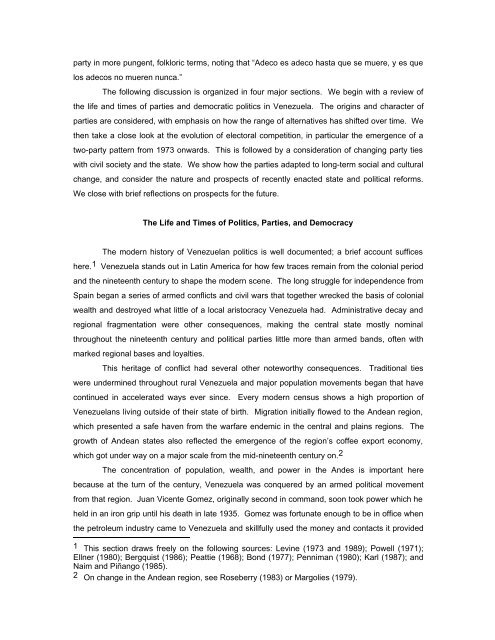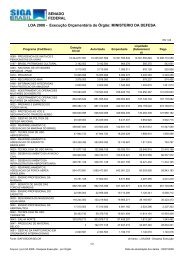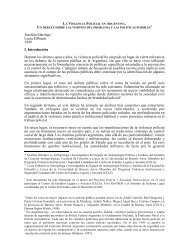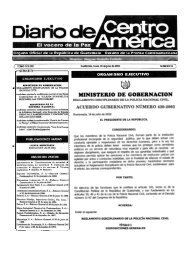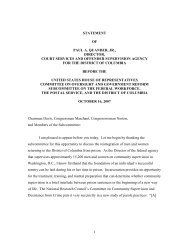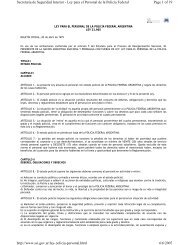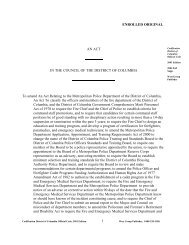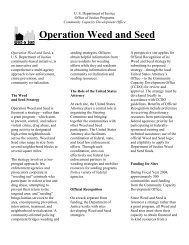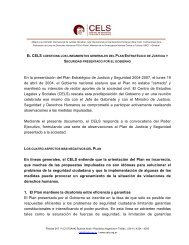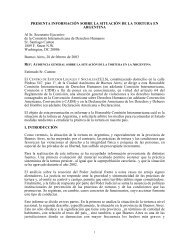Venezuela: The Life and Times of the Party System - Political ...
Venezuela: The Life and Times of the Party System - Political ...
Venezuela: The Life and Times of the Party System - Political ...
Create successful ePaper yourself
Turn your PDF publications into a flip-book with our unique Google optimized e-Paper software.
party in more pungent, folkloric terms, noting that “Adeco es adeco hasta que se muere, y es que<br />
los adecos no mueren nunca.”<br />
<strong>The</strong> following discussion is organized in four major sections. We begin with a review <strong>of</strong><br />
<strong>the</strong> life <strong>and</strong> times <strong>of</strong> parties <strong>and</strong> democratic politics in <strong>Venezuela</strong>. <strong>The</strong> origins <strong>and</strong> character <strong>of</strong><br />
parties are considered, with emphasis on how <strong>the</strong> range <strong>of</strong> alternatives has shifted over time. We<br />
<strong>the</strong>n take a close look at <strong>the</strong> evolution <strong>of</strong> electoral competition, in particular <strong>the</strong> emergence <strong>of</strong> a<br />
two-party pattern from 1973 onwards. This is followed by a consideration <strong>of</strong> changing party ties<br />
with civil society <strong>and</strong> <strong>the</strong> state. We show how <strong>the</strong> parties adapted to long-term social <strong>and</strong> cultural<br />
change, <strong>and</strong> consider <strong>the</strong> nature <strong>and</strong> prospects <strong>of</strong> recently enacted state <strong>and</strong> political reforms.<br />
We close with brief reflections on prospects for <strong>the</strong> future.<br />
<strong>The</strong> <strong>Life</strong> <strong>and</strong> <strong>Times</strong> <strong>of</strong> Politics, Parties, <strong>and</strong> Democracy<br />
<strong>The</strong> modern history <strong>of</strong> <strong>Venezuela</strong>n politics is well documented; a brief account suffices<br />
here. 1 <strong>Venezuela</strong> st<strong>and</strong>s out in Latin America for how few traces remain from <strong>the</strong> colonial period<br />
<strong>and</strong> <strong>the</strong> nineteenth century to shape <strong>the</strong> modern scene. <strong>The</strong> long struggle for independence from<br />
Spain began a series <strong>of</strong> armed conflicts <strong>and</strong> civil wars that toge<strong>the</strong>r wrecked <strong>the</strong> basis <strong>of</strong> colonial<br />
wealth <strong>and</strong> destroyed what little <strong>of</strong> a local aristocracy <strong>Venezuela</strong> had. Administrative decay <strong>and</strong><br />
regional fragmentation were o<strong>the</strong>r consequences, making <strong>the</strong> central state mostly nominal<br />
throughout <strong>the</strong> nineteenth century <strong>and</strong> political parties little more than armed b<strong>and</strong>s, <strong>of</strong>ten with<br />
marked regional bases <strong>and</strong> loyalties.<br />
This heritage <strong>of</strong> conflict had several o<strong>the</strong>r noteworthy consequences. Traditional ties<br />
were undermined throughout rural <strong>Venezuela</strong> <strong>and</strong> major population movements began that have<br />
continued in accelerated ways ever since. Every modern census shows a high proportion <strong>of</strong><br />
<strong>Venezuela</strong>ns living outside <strong>of</strong> <strong>the</strong>ir state <strong>of</strong> birth. Migration initially flowed to <strong>the</strong> Andean region,<br />
which presented a safe haven from <strong>the</strong> warfare endemic in <strong>the</strong> central <strong>and</strong> plains regions. <strong>The</strong><br />
growth <strong>of</strong> Andean states also reflected <strong>the</strong> emergence <strong>of</strong> <strong>the</strong> region’s c<strong>of</strong>fee export economy,<br />
which got under way on a major scale from <strong>the</strong> mid-nineteenth century on. 2<br />
<strong>The</strong> concentration <strong>of</strong> population, wealth, <strong>and</strong> power in <strong>the</strong> Andes is important here<br />
because at <strong>the</strong> turn <strong>of</strong> <strong>the</strong> century, <strong>Venezuela</strong> was conquered by an armed political movement<br />
from that region. Juan Vicente Gomez, originally second in comm<strong>and</strong>, soon took power which he<br />
held in an iron grip until his death in late 1935. Gomez was fortunate enough to be in <strong>of</strong>fice when<br />
<strong>the</strong> petroleum industry came to <strong>Venezuela</strong> <strong>and</strong> skillfully used <strong>the</strong> money <strong>and</strong> contacts it provided<br />
1 This section draws freely on <strong>the</strong> following sources: Levine (1973 <strong>and</strong> 1989); Powell (1971);<br />
Ellner (1980); Bergquist (1986); Peattie (1968); Bond (1977); Penniman (1980); Karl (1987); <strong>and</strong><br />
Naim <strong>and</strong> Piñango (1985).<br />
2 On change in <strong>the</strong> Andean region, see Roseberry (1983) or Margolies (1979).


